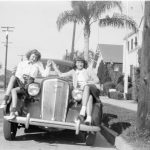Sometimes family historians have little choice when copying documents or photographs. Whether visiting relatives to share photographs or courthouses to research deeds, we are more likely to carry a digital camera than a scanner.
In this week’s eNews from the New England Historic Genealogical Society, Michael Leclerc discusses the relative merits of both scanning and photocopying as a means for duplicating original photos and documents. He particularly cautions against using a scanner, with its bright light, for fragile originals,
Documents that are in fragile condition, with faded writing, should not be scanned. The bright light can cause even more fading. If they must be scanned, you must be certain to scan them as few times as possible. Every time the image is exposed to the bright light, you are causing damage. Sometimes the damage is not visible to the naked eye, but it will eventually show up in the document.
Michael goes on to describe a safer practice by using a tripod-mounted camera to photograph documents and images, and notes, “Scanners and cameras take the same types of digital images (TIFFs, JPEGs, etc.). A scanner is, in reality, just a fancy camera.”
After seeing Ancestry.com’s scanning setup for conferences, I can see where each method has its merits. Scanning can be automated with a sheet-feeding machine, or set up to perform photo-corrections during the scanning. This saves considerable time on the processing and editing end, making a scanner a good choice for newer, less-fragile objects.
A photo copy stand, however, like the one used to copy my old newspapers and described in an earlier post, was even quicker in copying than a scanner. The real delay was in moving and setting up each shot.
I primarily scan old photos and documents to create archive TIFF copies. This format is unsupported by my digital camera, but better for archiving than JPG. An alternative would be to shoot photos in JPG and convert to TIFF for archiving.
Michael makes an excellent case for using a camera to copy fragile or old photos and documents and reinforces the usability of a digital camera.
Further Reading:
Ancestry.com Scans Old Newspapers, Freedom from the Flatbed
Hi Geniaus and thank you for the heads-up. I think the link should work now.
Most photo editing software offer a few file formats under the save or export option. Use TIF for archiving as it is less “lossy” than JPG.
Your tripod mounted camera sounds like a good idea. I hope you will come back and share any tips you find to make the work easier.
Thanks for commenting.






Great post! This is really cool. Your blog has given me a lot of insight into this type of technology. Keep up the great work here!
Thanks for posting this information. When I finally get a chance to hit the road, I'll probably rely mainly on my digital camera although I'm still contemplating investing in a portable scanner.
Many cameras, especially DSLRs allow you to save in the RAW format. It can be a good alternative to TIFF.
I used my camera and tripod to make copies at a family reunion and it worked great. However, especially when it comes to letters the results are different. The best I can describe it is that the camera takes a photograph and the scanner makes a digital image. They look completely different. I prefer the look of the scanner if possible for documents. I'm hoping to get permission to look at some fragile old record books at a church this fall. If I go, I will probably take a folding tv tray that will fit under the tripod and a book cradle. I will need to tilt the camera from page to page to copy but the books are evidently very fragile. Does anyone have suggestions for inexpensive portable lighting?
I've been using a camera on my visits to libraries, archives etc and find that, because of its portability, it is very convenient.
As scanning photos in albums can be very difficult I have gotten myself a little tripod and am experimenting with photographing them. I usually scan images as tiff but my camera does not offer this format either. I hadn't though of converting archive copy to a tiff….Duhh!
Thanks for the reminder.
BTW The link for your earlier post doesn't seem to be working.